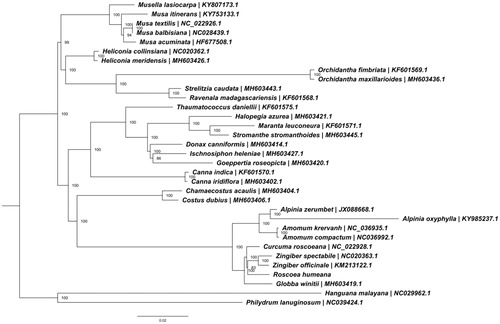Abstract
The complete chloroplast genome sequence of Roscoea humeana (Zingiberaceae), an alpine ginger in the Hengduan Mountains, China is reported in this study. The complete chloroplast genome is 160,288 base pairs (bp) in length, containing two inverted repeat (IRa and IRb) regions of 26,852 bp, which was separated by a small single-copy region of 18,788 bp and a large single-copy region of 87,796 bp. The overall GC contents of the plastid genome were 36.1%. In total, 116 unique genes were annotated and they were consisted of 82 protein-coding genes, 30 tRNA genes, and four rRNA genes. Phylogenetic analysis based on 33 chloroplast genomes indicates that R. humeana is closely related to Zingiber spectabile and Z. officinale.
Most species in the ginger family are confined to the lowland tropics of Africa, Asia, and Americas, but Cautleya (∼2 species) and Roscoea (∼21 species) are found at high elevations in the Pan-Himalaya (Kress et al. Citation2002). Consequently, the genetic and genomic information of alpine gingers is needed to evaluate how a tropical plant family has colonized alpine regions (Zhao et al. Citation2016). Here, we made the first report of a complete plastome for Roscoea humeana, an alpine ginger in the Hengduan Mountains, China (GenBank accession number: MK443505).
Roscoea humeana was sampled from (Lijiang, China; coordinates: 27.0914°N, 100.2630°E), and the voucher specimen was deposited at the Herbarium of Xishuangbanna Tropical Botanical Garden (HITBC150232). Genomic DNA was extracted from the fresh leaves using the modified CTAB method (Doyle and Doyle Citation1987). Subsequently, the cp genome were amplified using long-range PCR with fifteen run and Paired-end sequencing (250 bp) was performed on the Illumina MiSeq 2000 at the Laboratory of Molecular Biology of Germplasm Bank of Wild Species in Southwest China. High-quality reads were assembled into contigs using the de novo assembler in CLC Genomics Workbench v6.5 (CLC Bio), using a k-mer of 64 and a minimum contig length of 500 bp. The de novo contigs were assembled into complete chloroplast genomes followed the procedure of Yang et al. (Citation2004). The assembled chloroplast genome sequence was then annotated using DOGMA (Wyman et al. Citation2004) and manually corrected.
The complete chloroplast genome of R. humeana is 160,288 base pairs (bp) in length and contains two inverted repeat (IRa and IRb) regions of 26,852 bp, which was separated by a small single-copy (SSC) region of 18,788 bp and a large single-copy (LSC) region of 87,796bp. The new sequence possesses total 116 genes, including 82 protein-coding genes, four ribosomal RNA genes, and 30 tRNA genes. In these genes, six tRNA genes (i.e. trnA-UGC, trnK-UUU, trnE-UUC, trnL-UAA, trnS-CGA, and trnV-UAC) and seven protein-coding genes (atpF, clpP, ndhA, ndhB, rpoC1, rps12, and rps16) contained one intron, and the ycf3 gene has two introns. The overall GC content of the genome was 36.1%, and the corresponding value of the LSC, SSC, and IR region were 33.9%, 29.4%, and 42.4%, respectively.
We used RAxML (Stamatakis Citation2014) with 1000 bootstraps under the GTRGAMMAI substitution model to reconstruct a maximum likelihood (ML) phylogeny of 30 published plastomes of Zingiberales and the chloroplast sequence of R. humeana, using two species in Commelinales (Hanguana malayana and Philydrum lanuginosum) as outgroups. The phylogenetic analysis indicated that R. humeana is closely related Zingiber spectabile and Z. officinale in our study (). The complete plastome sequence of R. humeana will provide a useful resource for further studies on genomic diversity, origin, and evolution of alpine gingers.
Figure 1. ML phylogenetic tree of the 31 Zingiberales, based on the available chloroplast genome sequences in GenBank and the chloroplast sequence of Roscoea humeana. The tree is rooted using Commelinales (Hanguana malayana and Philydrum lanuginosum) as outgroups. Bootstraps (1000 replicates) are shown at the nodes.

Disclosure statement
No potential conflict of interest was reported by the authors.
Additional information
Funding
References
- Doyle JJ, Doyle JL. 1987. A rapid DNA isolation procedure for small quantities of fresh leaf tissue. Phytochem Bull. 19:11–15.
- Kress WJ, Prince LM, Williams KJ. 2002. The phylogeny and a new classification of the gingers (Zingiberaceae): evidence from molecular data. Am J Bot. 89:1682–1696.
- Stamatakis A. 2014. RAxML version 8: a tool for phylogenetic analysis and post-analysis of large phylogenies. Bioinformatics. 30:1312–1313.
- Wyman SK, Jansen RK, Boore JL. 2004. Automatic annotation of organellar genomes with DOGMA. Bioinformatics. 20:3252–3255.
- Yang SX, Yang JB, Lei LG, Li DZ, Yoshino H, Ikeda T. 2004. Reassessing the relationships between Gordonia and Polyspora (Theaceae) based on the combined analyses of molecular data from the nuclear, plastid and mitochondrial genomes. Plant Syst Evol. 248:45–55.
- Zhao J-L, Xia Y-M, Cannon CH, Kress WJ, Li Q-J. 2016. Evolutionary diversification of alpine ginger reflects the early uplift of the Himalayan–Tibetan plateau and rapid extrusion of indochina. Gondwana Res. 32:232–241.
